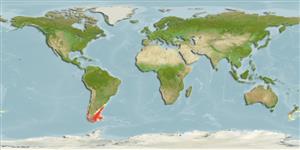Mammalia |
Cetartiodactyla |
Delphinidae
Environment: milieu / climate zone / depth range / distribution range
Ecology
Pelagic. Temperate; 0°N - 90°S, 180°W - 180°E
Southeast Pacific and Southwest Atlantic.
Length at first maturity / Size / Weight / Age
Maturity: Lm ? range ? - ? cm Max length : 216 cm TL male/unsexed; (Ref. 1394); max. published weight: 115.0 kg (Ref. 1394)
Coastal animals, found in bays and inlets, around islands and over the continental shelf; frequently seen close to shore and sometimes shoreward of kelp beds. Feeds on octopus, róbalo (snooks, family Centropomidae) and pejerrey (silversides, family Atherinidae) (Ref. 1394). Coastal animals, found in bays and inlets, around islands and over the continental shelf; frequently seen close to shore and sometimes shoreward of kelp beds. Feeds on octopus, róbalo (snooks, family Centropomidae) and pejerrey (silversides, family Atherinidae) (Ref. 1394).
Life cycle and mating behavior
Maturity | Reproduction | Spawning | Eggs | Fecundity | Larvae
Jefferson, T.A., S. Leatherwood and M.A. Webber 1993 FAO species Identification Guide: Marine Mammals of the World. Rome, FAO. 320 p. + 587 figures. (Ref. 1394)
IUCN Red List Status
(Ref. 130435: Version 2025-1)
CITES status (Ref. 108899)
Threat to humans
Human uses
Fisheries: commercial
FAO - Fisheries: landings, species profile | FishSource | Sea Around Us
Tools
More information
Trophic EcologyFood items (preys)
Diet composition
Food consumption
Predators
Population dynamicsGrowth
Max. ages / sizes
Length-weight rel.
Length-length rel.
Length-frequencies
Mass conversion
Abundance
Life cycleReproduction
Maturity
Fecundity
Spawning
Eggs
Egg development
Larvae
PhysiologyOxygen consumption
Human RelatedStamps, coins, misc.
Internet sources
Estimates based on models
Preferred temperature
(Ref.
115969): 6.4 - 15.6, mean 10.5 (based on 438 cells).
Fishing Vulnerability
Very high vulnerability (90 of 100).
Price category
Unknown.
